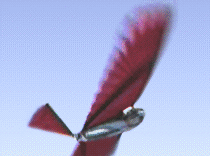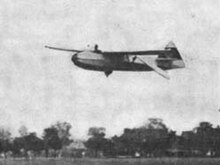Ornithopter
An ornithopter (from Greek ornithos "bird" and pteron "wing") is an aircraft that flies by flapping of the wings. Since many examples of flapping-wing flight exist in nature, such as birds, bats, and insects, designers seek to imitate this mode of flight. Ornithopters are usually built on the same scale as these flying creatures, though some scaled-up, person-carrying ones have also been built.

Early History
The idea of constructing wings in order to imitate the flight of birds dates to the ancient Greek legend of Daedalus and Icarus. Roger Bacon, writing in 1260, was among the first to consider a technological means of flight. Around 1490, Leonardo da Vinci began to study the flight of birds. He grasped that humans are too heavy, and not strong enough, to fly using wings simply attached to the arms. Therefore he proposed a device in which the aviator lies down on a plank and works two large, membranous wings using hand levers, foot pedals, and a system of pulleys. He only made a small scale model.
The first ornithopters capable of flight were constructed in France in the 1870s. Gustav Trouvé's 1970 model flew a distance of 70 meters in a demonstration for the French Academy of Sciences. The wings flapped by gunpowder charges activating a bourdon tube. Jobert in 1971 used a rubber band to power a small model bird. Alphonse Penaud, Hureau de Villeneuve, Victor Tatin, and others soon followed with their own designs.
Around 1890, Lawrence Hargrave built several ornithopters powered by steam or compressed air. He introduced the use of small flapping wings providing the thrust for a larger fixed wing. This eliminated the need for gear reduction, thereby simplifying the construction. To achieve a more birdlike appearance, this approach is not generally favored today.
In the 1930s, Erich von Holst carried the rubber band powered bird model to a high state of development and great realism. Also in the 1930s, Alexander Lippisch and other researchers in Germany harnessed the piston internal combustion engine.
Flight with Person Onboard

Perhaps because the prevailing culture favors fixed wing aircraft, people are mainly aware of the failed attempts at flapping-wing flight. There have been a few successes as well.
In 1929, the human-muscle-powered ornithopter designed by Alexander Lippisch flew a distance of 250 to 300 meters after tow launch. The flight was extended by the pilot's effort, but it is not clear whether the ornithopter and pilot performed well enough to remain briefly at equilibrium after the tow launch. Later tow-launched flights include Bedford Maule (1942), Emil Hartmann (1959), and Vladimir Toporov (1993).
In 1942, Adalbert Schmid flew a motorized, person-carrying ornithopter at Munich-Laim. It was driven by small flapping wings mounted at the sides of the fuselage, behind a larger fixed wing. Fitted with a 3 hp Sachs motorcycle engine, it made flights up to 15 minutes in duration. Schmid later constructed a 10 hp ornithopter based on the Grunau-Baby IIa sailplane, which was flown in 1947. The second aircraft had flapping outer wing panels. [1]
A team at the University of Toronto Institute for Aerospace Studies, headed by professor James DeLaurier, worked for many years on an engine-powered, piloted ornithopter. In July 2006, DeLaurier's machine made a jet-assisted takeoff and 14-second flight.[2]
Practical Applications
Practical applications capitalize on the resemblance to birds. The Colorado Division of Wildlife has used these machines to help save the endangered Gunnison Sage Grouse. An artificial hawk under the control of an operator causes the grouse to remain on the ground so they can be captured for study.
Because ornithopters resemble birds, they could theoretically be used for military applications, such as spying without alerting the enemy that they are under surveillance. AeroVironment, Inc., led by Paul B. MacCready (Gossamer Albatross), has developed a remotely piloted ornithopter the size of a large insect for possible spy missions. As demonstrated by birds, flapping wings offer potential advantages in maneuverability and energy savings compared with fixed-wing aircraft.
MacCready also developed, for the Smithsonian Institution, a half-scale replica of the giant pterosaur, Quetzalcoatlus northropi. The model had a wingspan of 5.5 meters (18 feet) and featured a complex, computerized control system, just as the full-size pterosaur relied on its neuromuscular system to make constant adjustments in flight.
A research project by Georgia Tech scientist Robert C. Michelson is developing a Reciprocating Chemical Muscle for use in micro-scale aircraft with flapping wings. Michelson uses the term "entomopter" for this type of ornithopter. SRI International is developing polymer artificial muscles.
Flown by Hobbyists
Ornithopters are also built and flown by hobbyists. These range from light-weight models powered by rubber band, to larger, radio control ornithopters.
The rubber-band-powered model can be fairly simple in design and construction. Students as well as older hobbyists compete for the longest flight times with these models. An introductory model can be fairly simple in design and construction, but the advanced competition designs are extremely delicate and challenging to build. Roy White holds the US national record for indoor rubber-powered, with his flight time of 21 minutes, 44 seconds.
Commercial radio controlled designs stem from Percival Spencer's engine-powered Seagulls, developed circa 1958, and Sean Kinkade's work in the late 1990s. The wings are usually driven by an electric motor. RC birds are available in ready-made form, but many hobbyists enjoy experimenting with their own new wing designs and mechanisms. The opportunity to interact with real birds in their own domain also adds great enjoyment to this hobby. Birds are often curious and will follow or investigate the model while it is flying. In a few cases, RC birds have been attacked by real hawks!
Aerodynamics
Aerodynamically, ornithopters differ from fixed wing aircraft in that the driving airfoils have a reciprocating, rather than rotary, motion.
Typically, the driving airfoils are large, so that the volume of air acted on to produce thrust is maximized. Since the flapping airfoils may produce both lift and thrust, drag-inducing structures are minimized. These two advantages may allow ornithopters to achieve a high degree of efficiency in flight.
From general aerodynamic considerations, ornithopters appear to make more efficient use of power than rotating propeller or jet aircraft do. The difficulties that have prevented major practical application appear to be the required mechanisms and structures, and the comfort of passengers since the ornithopter body typically oscillates counter to the wing motion.
References
- ^ Bruno Lange, Typenhandbuch der deutschen Luftfahrttechnik, Koblenz, 1986.
- ^ Dr. James DeLaurier's report on the Flapper's July 8, 2006 Flight
External links
- The Ornithopter Zone web site
- Slide show introduction to ornithopters
- University of Toronto ornithopter project
- Fly the Ornithopter yourself with the OpenSource flightsimulator FlightGear
- Photographs from 1927 From the State Library& Archives of Florida
- The French Ornithopter web site
- web site of a member of URVAM
- gfraise ornithopter site (French)
- Entomopter web site
- BYU students fly tiny, birdlike 'ornithopter' at competition
- Lawrence Hargrave's ornithopters - State Library of NSW
